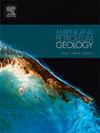Depositional architecture and evolution of Quaternary submarine canyon-fan system in the Baiyun Sag of the Pearl River Mouth Basin, northern South China Sea
IF 3.7
2区 地球科学
Q1 GEOSCIENCES, MULTIDISCIPLINARY
引用次数: 0
Abstract
Submarine canyons in the shelf margin usually serve as essential conduits for delivering sediments to slopes and basins and coevally develop turbidite reservoirs within deep-water fan systems. To understand the control of the evolution of the canyon-fan system, we focused on Quaternary deep-water depositional systems imaged in 3D seismic reflection data covering the lower reaches of the canyons and the base of the slope in the Baiyun Sag, on the northern margin of the South China Sea. By analyzing seismic facies tied to seismic attribute maps and time-thickness variations, three main seismic units were interpreted and described with markedly different geomorphologies and facies assemblages. Variations in the depositional architecture of the fan system recorded changes in sediment conditions during the Quaternary. The evolution of the Quaternary canyon-fan system can be summarized in three stages. Stage 1 is characterized by fan complexes with backstepping and stratigraphic onlapping against the erosional base, indicating a reduction in sediment supply due to rapid transgression during the Early Pleistocene. During Stage 2, the sediment supply decreased to its lowest rate, producing elongate-shaped turbidite complexes and a high proportion of hemipelagic deposits. In contrast, stage 3 was expressed by canyon-fan systems with downlapping stratigraphy resulting from the enhancement of sediment input during shelf margin/slope progradational intervals. The Quaternary canyon-fan system evolution was controlled not only by the rapid transgression but also by the efficiency of the sediment transfer mechanisms. Although higher rate of sediment supply occurred during stage 1, the dominant canyon-direct fed systems at this stage had highly efficient sediment transfer mechanisms, generating thicker and larger canyon-fan systems compared to stage 3. During stage 3, the progradation-direct-fed system became the primary sediment transport pattern causing sediment to mostly accumulate on the slope and reduce sediment delivery to the basin floor. Our results indicate that the distribution of gas hydrate accumulation is strongly associated with the depositional pattern of turbidites within the Lower Pleistocene succession.
南海北部珠江口盆地白云沙格第四纪海底峡谷-褶皱系统的沉积构造与演化
陆架边缘的海底峡谷通常是向斜坡和盆地输送沉积物的重要通道,并在深水扇形系统中共同发育浊积岩储层。为了解峡谷-扇系统演化的控制因素,我们重点研究了南海北缘白云嵯峨峡谷下游和坡底三维地震反射数据所显示的第四纪深水沉积系统。通过分析与地震属性图和时间厚度变化相关联的地震剖面,解释和描述了三个主要地震单元,其地貌和剖面组合明显不同。扇形系统沉积结构的变化记录了第四纪沉积条件的变化。第四纪峡谷-扇状系统的演变可概括为三个阶段。第 1 阶段的特征是扇形复合体与侵蚀基底之间存在后退和地层重叠,这表明早更新世时期的快速横断导致沉积物供应减少。在第 2 阶段,沉积物供应量降至最低,产生了细长形的浊积岩复合体和高比例的半沉积物。与此相反,第 3 阶段表现为地层重叠的峡谷-岩扇系统,这是由于在陆架边缘/斜坡前倾期间沉积物输入量增加所致。第四纪峡谷-扇形系统的演化不仅受制于快速的横断,还受制于沉积物转移机制的效率。虽然第 1 阶段的沉积物供应速度较快,但这一阶段的主要峡谷-直接馈源系统具有高效的沉积物转移机制,与第 3 阶段相比,其生成的峡谷-扇形系统更厚、更大。在第 3 阶段,渐变-直馈系统成为主要的沉积物运移模式,导致沉积物主要堆积在斜坡上,减少了向盆地底层的沉积物输送。我们的研究结果表明,在下更新世演替中,天然气水合物的堆积分布与浊积岩的沉积模式密切相关。
本文章由计算机程序翻译,如有差异,请以英文原文为准。
求助全文
约1分钟内获得全文
求助全文
来源期刊

Marine and Petroleum Geology
地学-地球科学综合
CiteScore
8.80
自引率
14.30%
发文量
475
审稿时长
63 days
期刊介绍:
Marine and Petroleum Geology is the pre-eminent international forum for the exchange of multidisciplinary concepts, interpretations and techniques for all concerned with marine and petroleum geology in industry, government and academia. Rapid bimonthly publication allows early communications of papers or short communications to the geoscience community.
Marine and Petroleum Geology is essential reading for geologists, geophysicists and explorationists in industry, government and academia working in the following areas: marine geology; basin analysis and evaluation; organic geochemistry; reserve/resource estimation; seismic stratigraphy; thermal models of basic evolution; sedimentary geology; continental margins; geophysical interpretation; structural geology/tectonics; formation evaluation techniques; well logging.
 求助内容:
求助内容: 应助结果提醒方式:
应助结果提醒方式:


